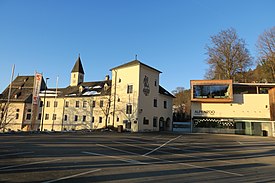Innsbruck Alpine Zoo
| Innsbruck Alpine Zoo | ||
|---|---|---|
| place | innsbruck | |
| surface | 5 hectares | |
| opening | 1962 | |
| Animal species | about 150 species | |
| Individuals | approx. 2000 animals | |
| Species focus | Animals of the Alpine region | |
| Visitor numbers | 341,486 (2014) | |
| organization | ||
| management | André Stadler (Director and Managing Director) | |
| Sponsorship | Nonprofit organization | |
| Funding organizations | Friends of the Alpine Zoo | |
| Member of | WAZA , EAZA , VdZ , OZO | |
|
Entrance area of the Alpenzoo with Weiherburg |
||
| www.alpenzoo.at | ||
|
|
||
Coordinates: 47 ° 16 '50 " N , 11 ° 23' 53" E
The Alpenzoo Innsbruck is one of the highest zoos in Europe (750 m). On an area of around 4.1 hectares, this themed zoo of alpine fauna houses a unique collection of 150 animal species with 2000 animals from the entire alpine region.
location
The alpine zoo is located on the slope of the Nordkette below the Hungerburg in the district of Hötting , immediately adjacent to the Weiherburg . It can be reached via the Hungerburgbahn with a short walk, via the bus line W or by car.
history
The alpine zoo was founded on September 22nd, 1962 by Hans Psenner . The zoo made a name for itself through resettlement projects for animal species that are extinct or threatened with extinction in Tyrol, such as the bearded vulture , ibex and bald ibex .
With the opening of the Innsbruck Alpine Zoo, a bridge was built to the Renaissance zoo from the 16th century, and part of its former surroundings and atmosphere were restored to the Weiherburg. Right at the entrance, the beaver enclosure with its "pond" is reminiscent of the historic fish ponds that gave the Weiherburg its name.
From 1962 to 1994 the Mayor of Innsbruck at the time, Alois Lugger, was President of the Alpenzoo Innsbruck-Tirol. He was succeeded by Herwig van Staa, who has held the office of President since 1994.
Hans Psenner (1912–1995) is known as the “father of the alpine zoo”, since he promoted the idea of establishing an “alpine zoo” to the public at a young age. In 1962 he was able to realize this life's work. Hans Psenner remained director until 1979. The zoo experienced a great boom under Helmut Pechlaner (director 1979–1991; 1992–2006 director of Vienna's Schönbrunn Zoo). He was followed by Michael Martys from 1992 to 2017; since then André Stadler has been the zoo director.
Investments
The bald ibis aviary, built in 2002, is accessible to visitors. The Alpine Zoo also coordinates the European conservation breeding program for the bald ibis . The zoo has a demonstration farm with ancient Tyrolean livestock breeds like Tux cattle , Pustertaler Sprintzen , Grauvieh , Original Brown Swiss , Turopolje pigs , Tauern Then , Peacock Goat , black-nosed sheep , Alpine stone sheep and glasses sheep and Altsteirer and Sulmtaler chickens .
In 2003 bison and brown bear moved into their new enclosures. In 2005 an accessible alluvial forest aviary and in 2006 the Paul Flora Rabenturm were completed, also in 2006 a large ibex enclosure and the “Innergschlöß” large aviary, a combination of bearded vultures with marmots and alpine crows. In 2008 the chamois moved into their new facility and in 2009 the new golden eagle, owl and grouse complex were opened. In 2010 the otter enclosure was expanded, and in the anniversary year 2012, a large Alpine lake aquarium and event rooms were completed on the site of the old terrace.
In 2014, the groundbreaking took place for the facility for black grouse, mountain hares and jays, which opened in 2015. On the occasion of its 35th anniversary, this was financed by the Friends of the Alpine Zoo.
In 2016 the new "Animahl" zoo restaurant opened.
In 2018 the pine marten moved into their new enclosure. In the same year, a geo-educational trail was opened that gives insights into the formation and special features of the Alps. Since June 2018 one has been learning a lot about honey bees and their numerous relatives in the “Sumsi World”.
At the end of September 2019, the up to 14 m high and over 1000 m 2 large Zogg Troller Aviary for griffon vultures and Egyptian vultures was opened.
particularities
The alpine zoo is the only zoo in the world that successfully keeps the wall creeper bird . The zoo also has what it claims to be the world's largest cold water aquarium.
literature
- Hans Psenner : The Alpine Zoo. My life , Wörgl 1982.
- Alpenzoo Innsbruck , in: Dirk Petzold, Silke Sorge (Ed.): Adventure Zoo. 550 animal parks, aquariums and reptile houses. The zoo guide for Germany, Austria and Switzerland , Graz 2007, pp. 353–356.
Web links
- Homepage of the Alpine Zoo
- Homepage of the Friends of the Alpenzoo (Friends' Association)
Individual evidence
- ↑ Data sheet for the Alpine Zoo on the homepage of the Association of Zoological Gardens, accessed on May 19, 2015.
- ↑ Tiroler Tageszeitung Online: Handover of the farm in the Alpenzoo in all friendship | Tiroler Tageszeitung online - news from now! In: Tiroler Tageszeitung Online . ( archive.org [accessed February 25, 2018]).
- ↑ Complete List of EEPs and ESBs ( Memento of November 4, 2016 in the Internet Archive ) on the EAZA website , accessed on May 16, 2016.
- ↑ New enclosure opened in the Alpine Zoo. Report on mein district.at from May 20, 2015.
- ↑ Fish in the Alpine Zoo. ( Memento from September 5, 2017 in the Internet Archive ) Homepage of the Alpenzoo, accessed on May 20, 2015.





